Pork Stew
Recipe Overview
Why you’ll love it: Pork stew is the heartiest of dinners, with tender pork, potatoes, and veggies simmered in an herbed broth. It makes a big batch so you can save some for later!
How long it takes: 2 hours
Equipment you’ll need: large pot or Dutch oven
Servings: 8 (2 cups each)
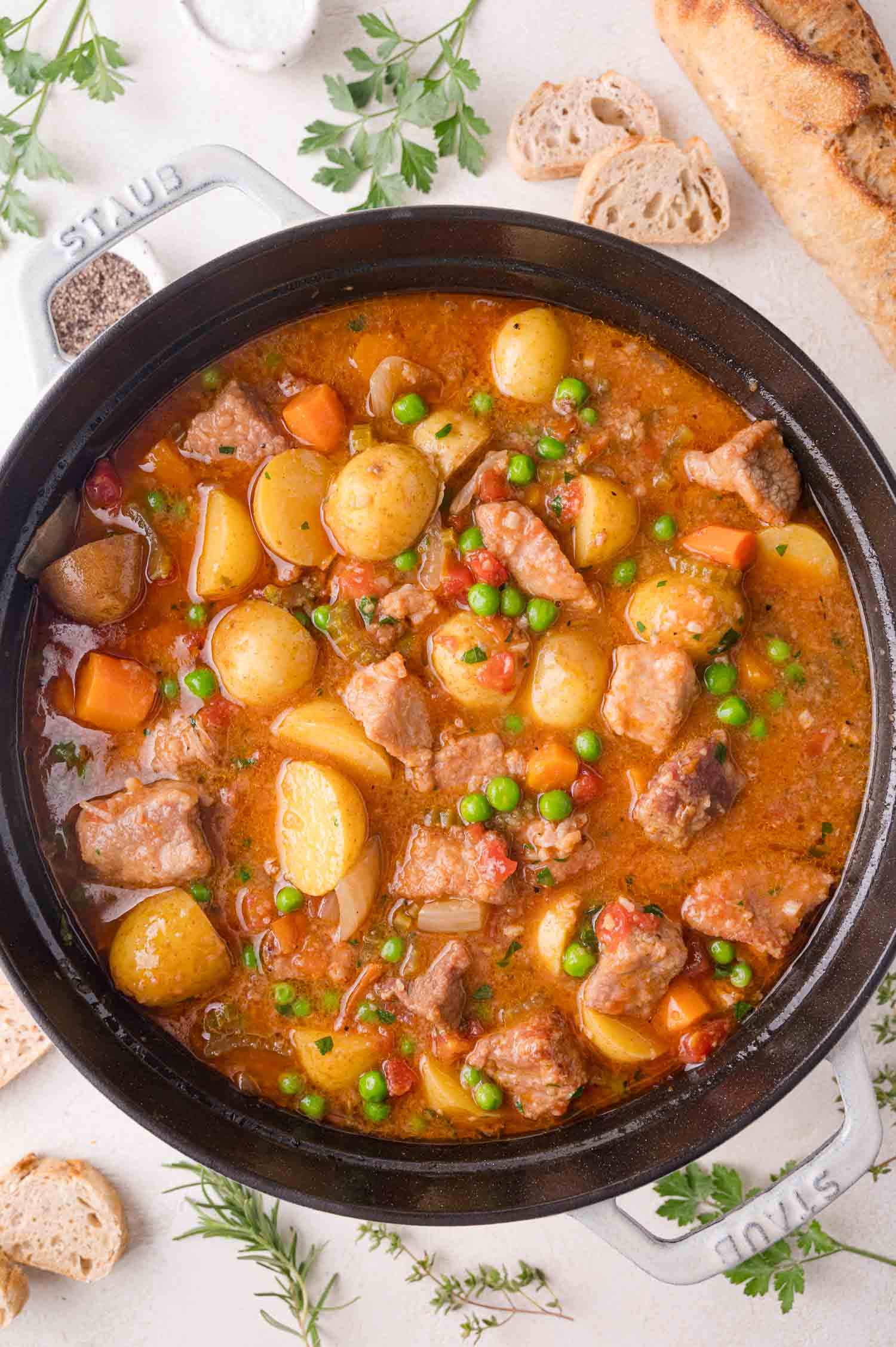
Pin this now to find it later
Move over beef stew, there’s a new hearty dinner in town! (On second thought, don’t move over too far—there’s definitely still room for crockpot beef stew and Instant Pot beef stew in my kitchen!)
This pork stew is a cozy combination of juicy slow-cooked pork, tender potatoes and veggies, and a rich, savory broth. We add lots of herbs and spices, which infuse so much flavor into every spoonful. It’s rustic comfort food to be sure, but all those flavors really elevate the dish.
Served with warm crusty bread for soaking up that broth (an absolute must if you ask me!), this stew is the perfect way to warm up on a chilly evening.
Hearty Pork Stew Recipe
Rich, complex flavors. The low and slow simmering on the stovetop coaxes out all the flavors from the pork and aromatics. (And needless to say, your house will smell AMAZING as the pork stew cooks in the kitchen.)
Customizable ingredients. This recipe is incredibly flexible, allowing you to swap out or add ingredients based on what’s in season or what’s been sitting in your crisper drawer.
Perfect for meal prep. Pork stew is fairly uncomplicated to make, the recipe yields a hefty eight servings, and the flavors only get better after sitting in the fridge overnight. This makes it an excellent choice for meal prep!
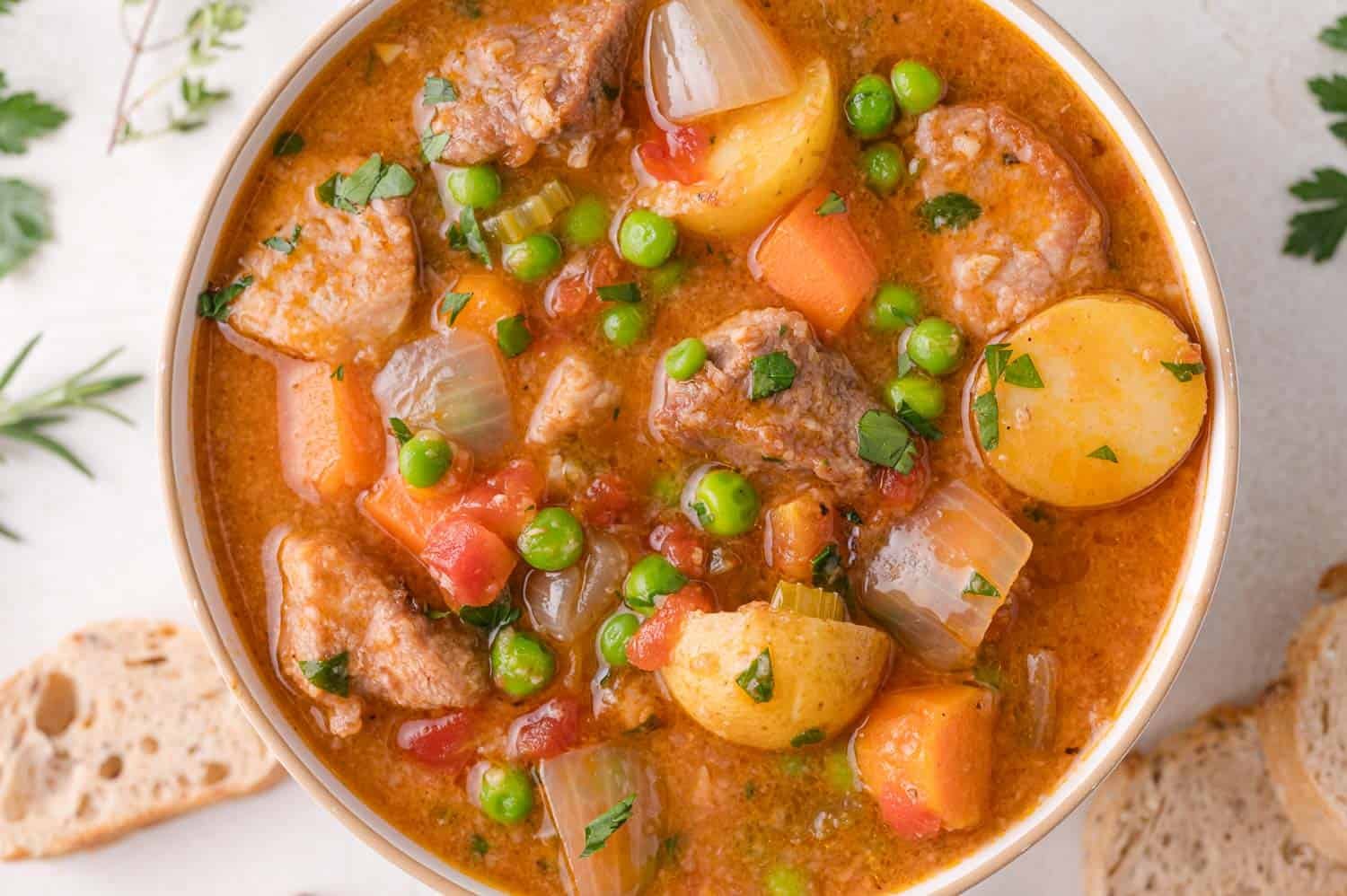
Ingredient Notes
- Pork shoulder: Buy boneless pork shoulder. Pork butt, Boston butt, or country spareribs can be used, too. You’ll need about 3 pounds. Pork shoulder is a cut that must be cooked low and slow to break down the connective tissue. (It’s also popular for making pulled pork.)
- All-purpose flour: The flour is mixed with seasonings and used to coat the pork before browning it. The seasoned flour forms a nice crust on the pork when seared and it also helps to thicken the stew.
- Seasonings: Kosher salt, paprika, black pepper, and garlic powder are mixed into the flour to season the pork.
- Oil or ghee: You’ll need an oil with a high smoke point for browning the pork, such as sunflower or canola oil. Ghee is better than butter for searing because it has a higher smoke point.
- Aromatic veggies: Carrots, celery, onion, and garlic are key players in many soup and stew recipes. The first three are also known as mirepoix.
- Tomato paste: A couple of tablespoons adds depth and richness (umami!) to the stew. You’ll have some leftover if you use canned tomato paste; I like to freeze it in tablespoon-size portions so I have just the amount I need for future recipes.
- Baby potatoes: Unless they are very small, I usually halve the baby potatoes. Regular-sized Yukon gold potatoes will work, too; you’ll just need to cut them into smaller pieces.
- Chicken broth: Low-sodium broth is best, or use homemade chicken stock.
- Diced tomatoes: You’ll add both the tomatoes and the liquid from the can.
- Herbs: I like to use fresh rosemary and thyme, along with a bay leaf in the stew. If you want to substitute dried herbs, use ½ teaspoon dried thyme and a ¼ teaspoon of crushed dried rosemary.
- Frozen peas: The peas are added near the end of the cooking time so they retain their bright color and flavor. You don’t need to thaw them first.
- Fresh parsley: Chopped parsley is stirred into the stew along with the peas. You can also garnish the stew with more parsley if you like.
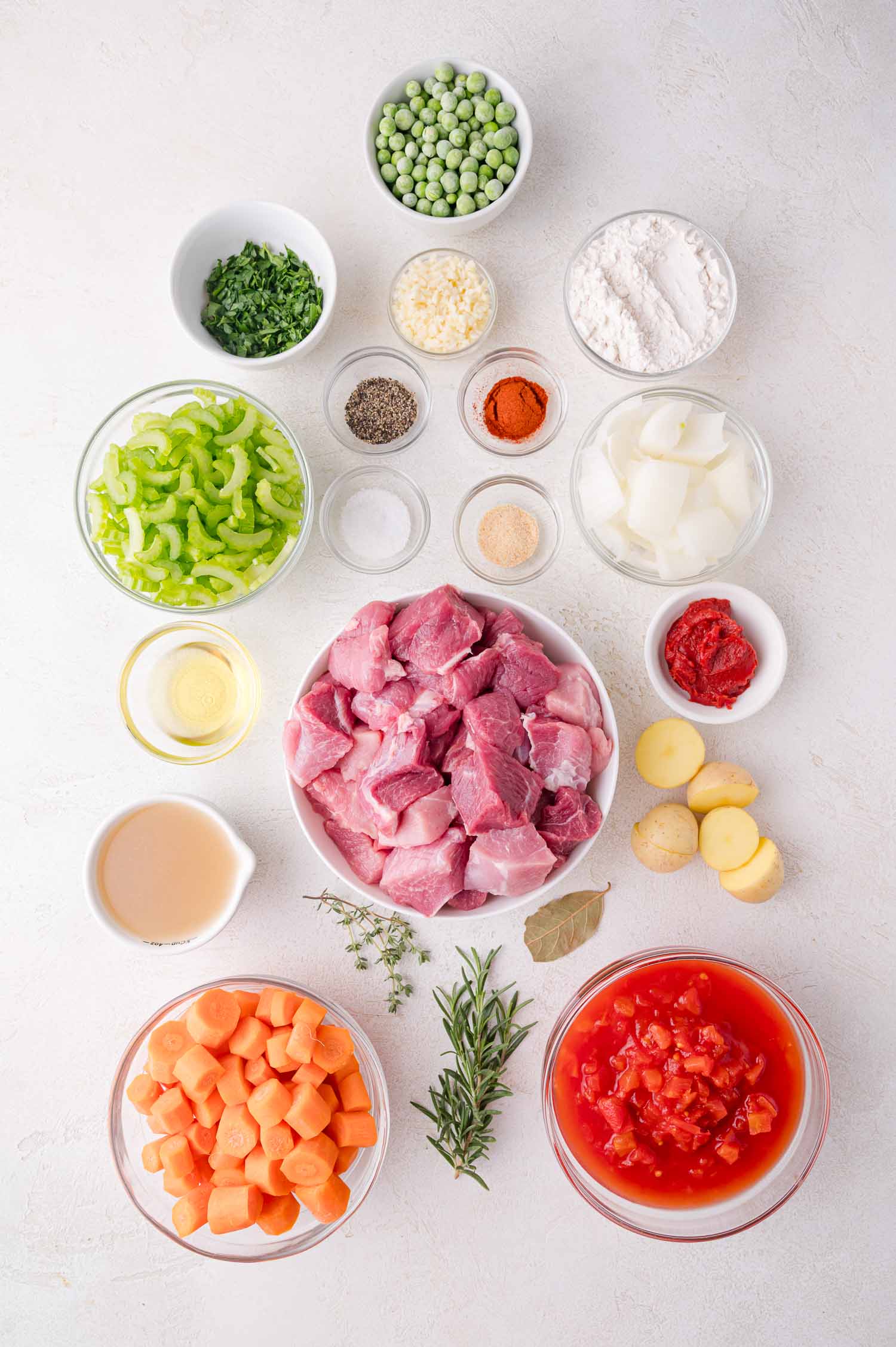
How to Make Pork Stew
Season the pork. Trim excess fat from the pork shoulder and cut it into large cubes, about 1 inch square. In a large bowl, whisk together the flour with a teaspoon of salt, a half teaspoon of pepper, paprika, and garlic powder. Toss the pork cubes in this mixture, coating it evenly.
Recipe Tip
If you chill the raw pork in the freezer for about an hour, it will be easier to cut into cubes.
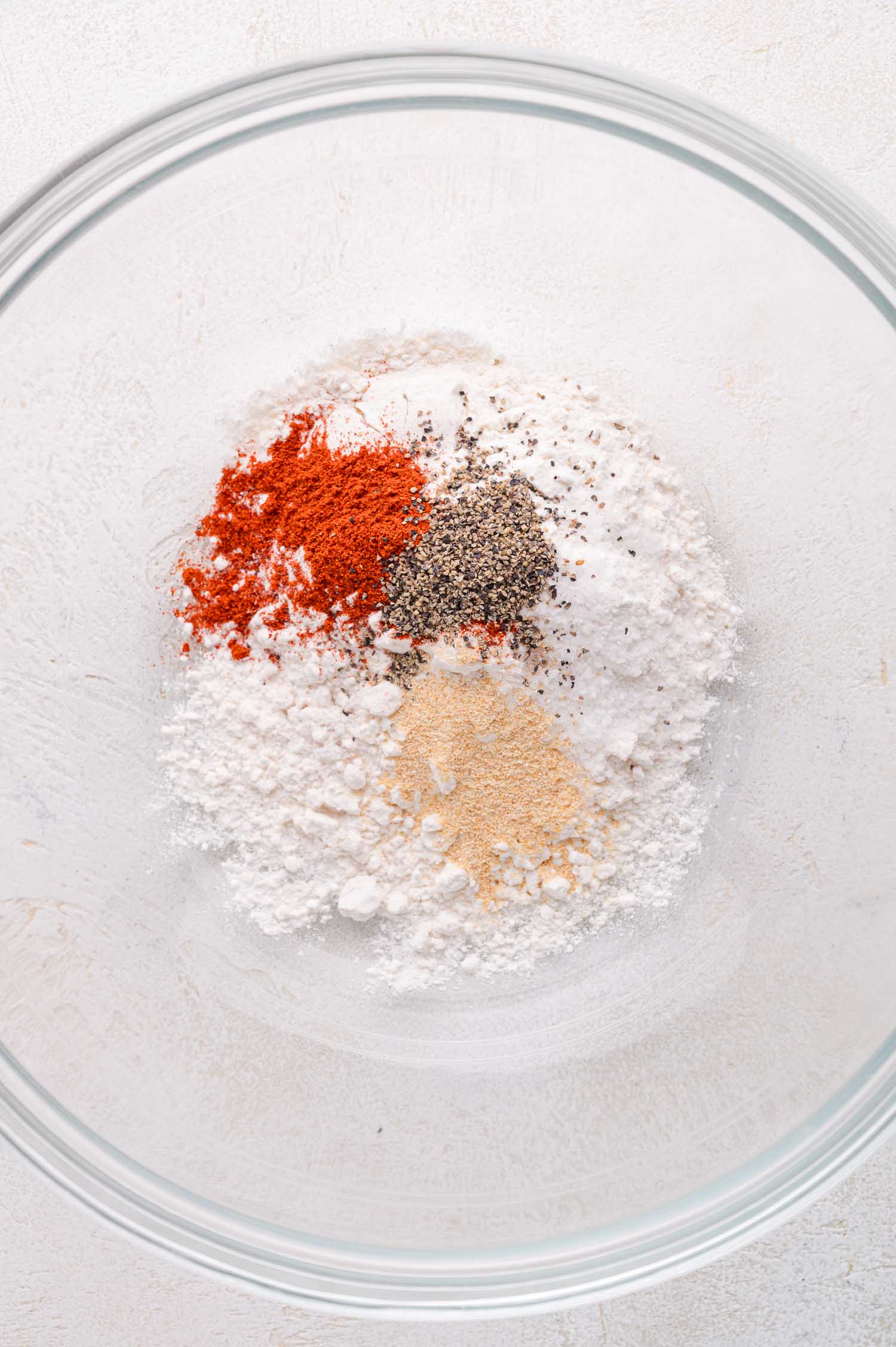
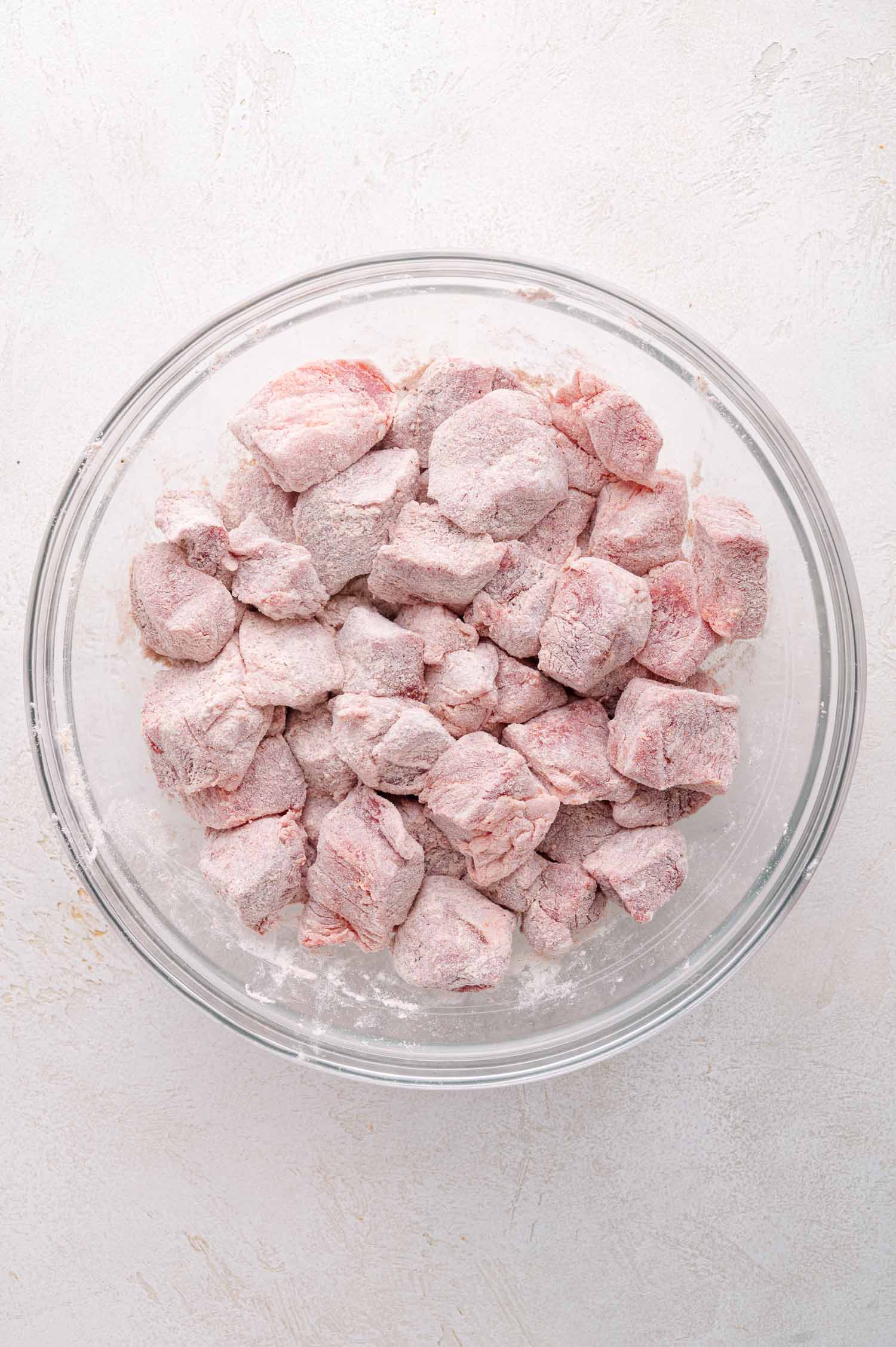
Sear the pork. Warm the oil or ghee in a large pot set over medium-high heat. When the pan is hot, add the pork in a single layer, avoiding overcrowding the pan. You’ll have to do this in batches. Brown the pork on all sides, transfer to a plate, and cook another batch, adding more oil/ghee as needed. The pork doesn’t need to be cooked all the way through, but simply well-browned on the outside surface. (Save any flour that’s at the bottom of the bowl after you’ve removed and cooked the pork.)
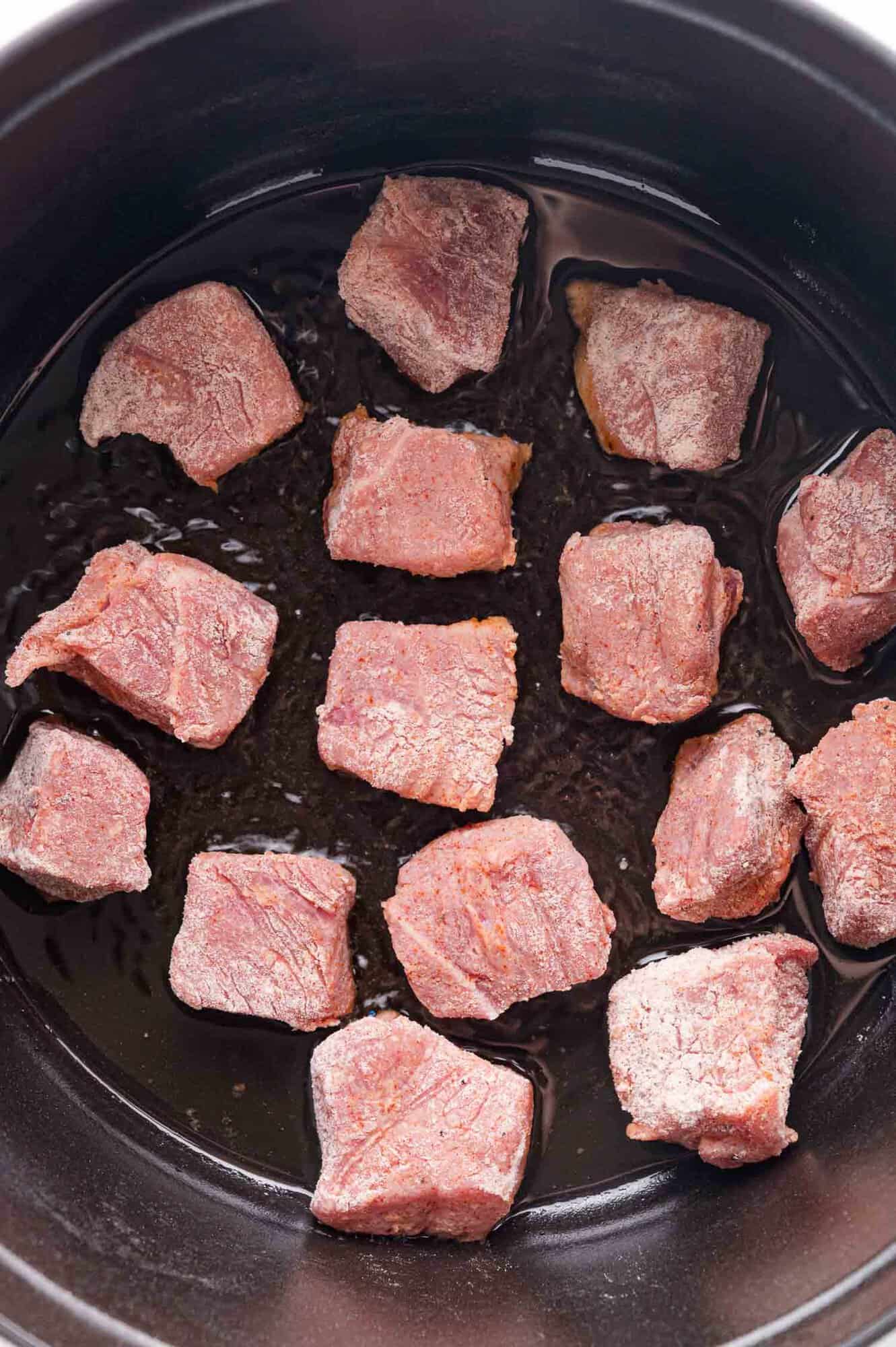
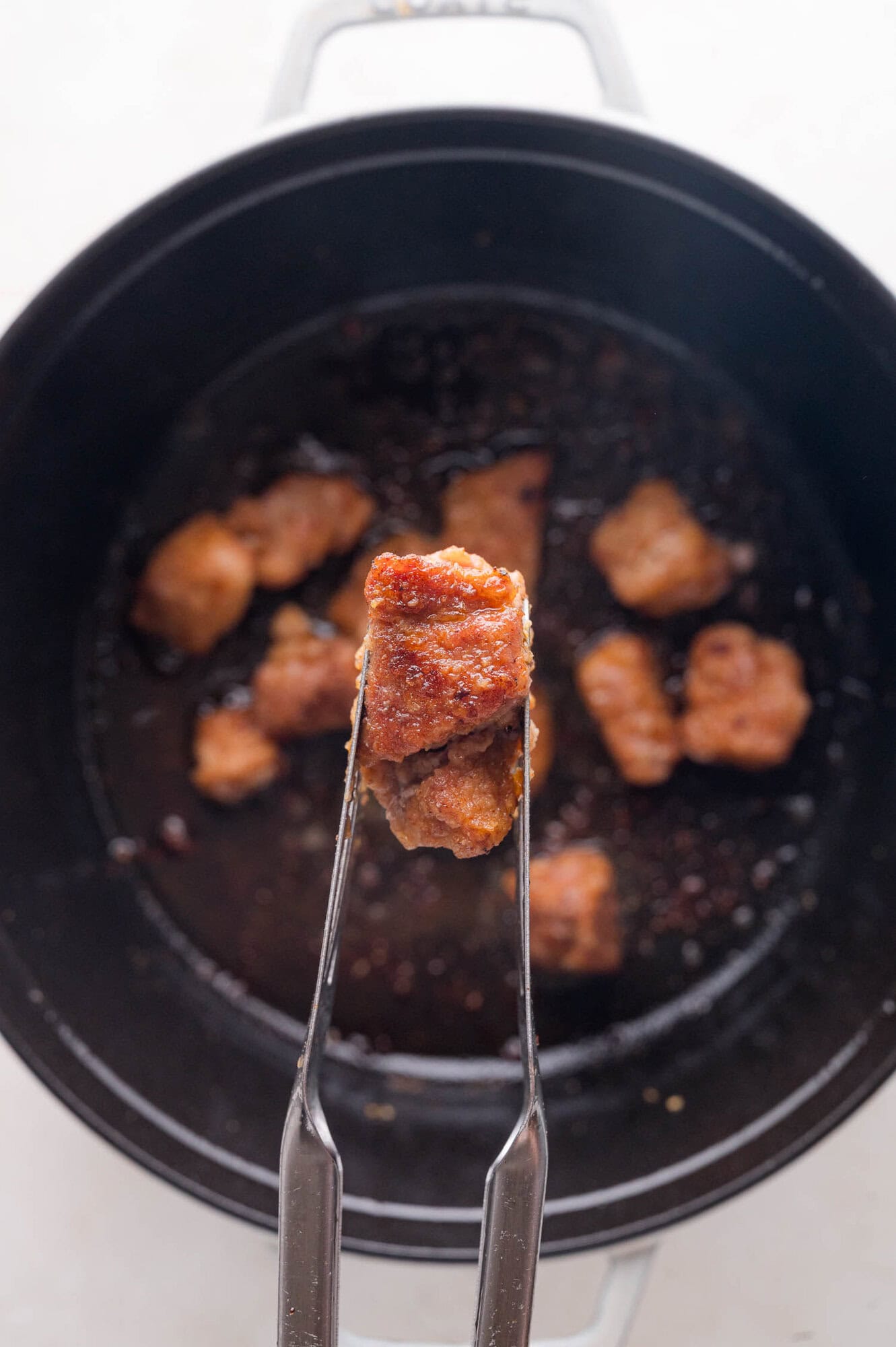
Cook the aromatics. Add the carrots, celery, onion, salt, and pepper to the pot. Cook just enough to soften the veggies a bit (they’ll soften more while they cook in the stew). Stir in the garlic and cook it until it’s fragrant, then stir in any flour mixture you saved from the bowl.
Deglaze the pan. After the flour is golden, stir in the tomato paste. Let it cook for a bit (this brings out its flavor!), and then pour in the broth. Use a wooden spoon to scrape up brown bits from the bottom of pan to incorporate them into the liquid.
Simmer. Stir in the browned pork, potatoes, tomatoes, and herbs. Add more broth if needed; however, everything doesn’t need to be completely submerged. Bring the pork stew to a boil over high heat, then reduce the heat to low, cover, and simmer for an hour and 15 minutes, stirring occasionally. The stew should be gently simmering, not boiling rapidly.
Finish. Stir in the peas and parsley during the last 10 minutes of simmering time. Add more broth if desired. Once the stew is done, discard the bay leaf and the stems of the fresh herbs (the leaves will have fallen off). Taste the stew and season to taste with additional salt and pepper. Serve in shallow bowls.
Serving Suggestions
Refrigerate: Store leftover pork stew in an airtight container in the refrigerator for 3 to 4 days. If I know we’re going to have the leftovers for lunches, I’ll ladle it into smaller containers and stack them in the fridge.
Freeze: If you have more leftovers than you can eat within a few days, freezing is a great option; just note that the texture of the potatoes can change with freezing and reheating. Transfer the stew into freezer-safe containers or zip-top bags and freeze for up to 3 months. Thaw in the refrigerator before reheating.
Reheat: To reheat pork stew, you can either use the stovetop or microwave. For the stovetop method, place the desired amount of stew in a pot and cook over medium heat, stirring occasionally, until heated through. If using the microwave, heat up individual servings in microwave-safe bowls.
- 3 pounds boneless pork shoulder, excess fat trimmed, and cut into 1-inch pieces (see note)
- ½ cup all-purpose flour
- 1 ½ teaspoons kosher salt, divided
- 1 teaspoon coarse ground black pepper, divided
- 1 teaspoon paprika
- ½ teaspoon garlic powder
- 2 tablespoons oil or ghee
- 4 medium carrots, cut into ½-inch slices (about 2 cups)
- 4 stalks celery, cut into ¼-inch slices (about 2 cups)
- 1 large onion, chopped (about 2 cups)
- 4 cloves garlic, minced
- 2 tablespoons tomato paste
- 3 to 4 cups chicken broth, divided (low sodium preferred)
- 1 pound baby potatoes, halved (or Yukon gold potatoes, cut into 1-inch pieces)
- 1 can (14.5 ounces) diced tomatoes, undrained (no salt added preferred)
- 1 sprig fresh rosemary
- 1 sprig fresh thyme
- 1 large bay leaf
- 2 cups frozen peas
- ½ cup chopped fresh parsley
In a large bowl, combine flour, 1 teaspoon salt, ½ teaspoon pepper, paprika, and garlic powder. Add pork and toss, coating all sides of pork cubes with flour mixture. Don’t discard any leftover flour mixture at the bottom of the bowl.
3 pounds boneless pork shoulder, excess fat trimmed, and cut into 1-inch pieces, ½ cup all-purpose flour, 1 teaspoon paprika, ½ teaspoon garlic powder
In a large pot or Dutch oven, heat oil over medium-high heat. Add floured meat to pan in a single layer. You will have to do this in batches, trying not to overcrowd the pan. Brown the cubed pork on all sides, about 5 minutes per batch. Add more oil if needed. Remove the pork from pan and repeat until all the meat is browned. The meat won’t be fully cooked, just nicely browned on the outside.
2 tablespoons oil or ghee
Add carrots, celery, onion, ½ teaspoon salt, and ¼ teaspoon pepper to pot and cook, stirring, for 7 to 8 minutes or until onions are translucent.
4 medium carrots, cut into ½-inch slices, 4 stalks celery, cut into ¼-inch slices, 1 large onion, chopped
Add garlic and cook for one minute or until fragrant. Add any leftover flour mixture and stir and continue to cook for 1 to 2 minutes. Add tomato paste, stirring to combine.
4 cloves garlic, minced, 2 tablespoons tomato paste
Add broth, scraping any brown bits off the bottom of pan.
3 to 4 cups chicken broth, divided
Add browned pork, potatoes, and tomatoes to pan. Add rosemary, thyme, and bay leaf (you’ll remove and discard these later). Stir to combine. The ingredients should be mostly, but don’t have to be completely submerged. If needed, add a little broth.
1 pound baby potatoes, halved, 1 can (14.5 ounces) diced tomatoes, undrained, 1 sprig fresh rosemary, 1 sprig fresh thyme, 1 large bay leaf
Turn heat to high to bring stew to a boil, then reduce to low or medium-low to maintain a simmer. Cover and cook for 1 hour, 15 minutes, stirring occasionally. The stew should be gently simmering, not rapidly boiling. If needed, lower the heat.
About 10 minutes before serving, stir in peas (no need to thaw!) and parsley. If the stew seems too thick, add more broth until it’s the desired consistency.
2 cups frozen peas, ½ cup chopped fresh parsley
Before serving, remove stems of herbs and bay leaf. Taste the stew; season with salt and pepper as needed.
- Pork: I usually use boneless pork shoulder but boneless pork butt (Boston butt) would work fine, too. Another option is boneless country ribs which are another pork shoulder cut.
- Pro tip: Chill the pork for about an hour in the freezer before cutting it into chunks. The semi-frozen meat will cut more easily.
- Crockpot cooking method: To make pork stew in your slow cooker, refer to my crockpot beef stew, substituting pork for the beef. The ingredients are slightly different but the instructions will be the same.
Serving: 2cups, Calories: 403kcal, Carbohydrates: 31g, Protein: 46g, Fat: 10g, Saturated Fat: 2g, Polyunsaturated Fat: 2g, Monounsaturated Fat: 5g, Trans Fat: 0.04g, Cholesterol: 102mg, Sodium: 705mg, Potassium: 1408mg, Fiber: 6g, Sugar: 7g, Vitamin A: 6033IU, Vitamin C: 41mg, Calcium: 83mg, Iron: 4mg
Nutrition information is automatically calculated, so should only be used as an approximation.

